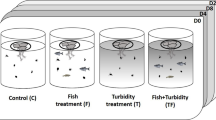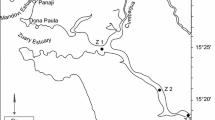Abstract
An enclosure experiment in the Patos Lagoon estuary, southern Brazil (32°S, 52°W) investigated the response of phytoplankton to the enhancement of mesozooplankton and fish abundance. Addition of nutrients (NO3 − and PO4 −) stimulated the growth of 3–20 μm diameter phytoplankton, especially the diatomCylindrotheca closterium, which, in turn, was heavily grazed by the dominant mesozooplankter, the copepodAcartia tonsa. Acartia did not consume small (2–3 μm) autotrophic flagellates and the cyanobacteriaAnabaena sp., despite their high cell number. Largest grazing ofC. closterium by the copepod occurred only after a decrease of ciliate abundance. The addition of mesozooplankton did not change the levels of primary production, but it significantly increased the phytoplankton assimilation number. Highest chlorophylla concentrations were measured in enclosures stocked with juveniles of the fishXenomelaniris brasiliensis. The large phytoplankton biomass and low mesozooplankton abundance found in this treatment indicates an, effective predator-mediated action on the phytoplankton community.
Similar content being viewed by others
Literature Cited
Abreu, P. C.. 1987. Variaçao temporal da biomassa fitoplanctônica (clorofilaa) na região de acesso ao estuário da Lagoa dos Patos, RS—Brasil. M.S. Thesis, University of Rio Grande-FURG, RS, Brazil.
Abreu, P. C.. 1992. Phytoplankton production and the microbial food web of the Patos Lagoon estuary, southern Brazil. Ph.D. Dissertation. University of Bremen, Federal Republic of Germany.
Abreu, P. C., B. Biddanda, andC. Odebrecht. 1992. Bacterial dynamics of the Patos Lagoon estuary, southern Brazil (32°S, 52°W): Relationship with phytoplankton production and suspended material.Estuarine, Coastal and Shelf Science 6:621–635.
Abreu, P. C., C. Oderbrecht, andA. González. 1994. Particulate and dissolved phytoplankton production of the Patos Lagoon estuary, Southern Brazil: Comparison of methods and influencing factors.Journal of Plankton Research 16:737–753.
Arcifa, M. S., T. G. Northcote, andO. Froehlich. 1986. Fishzooplankton interactions and their effects on water quality of a tropical Brazilian reservoir.Hydrobiologia 139:49–58.
Bemvenuti, M. A. 1990. Hábitos alimentares de peixes-rei (Atherinidae) na região estuarina da Lagoa dos Patos, RS, Brazil.Atlântica, Rio Grande 12:79–102.
Bergesch, M. 1990. Variações de biomassa e composição do fitoplâncton na área estuarina rasa da Lagoa dos Patos e suas relações com factores de influência. M.S. Thesis, University of Rio Grande-FURG, RS, Brazil.
Berggreen, U., B. Hansen, andT. Kørboe. 1988. Food size spectra, ingestion and growth of the copepodAcartia tonsa during development: Implications for determination of copepod production.Marine Biology 99:341–352.
Carpenter, S. R., J. F. Kitchell, andN. Corwin. 1985. Cascading trophic interactions and lake productivity.BioScience 35:364–369.
Carpenter, S. R., J. F. Kitchell, J. R. Hodgson, P. A. Cochran, J. J. Elser, M. Elser, D. M. Lodge, D. Kretchner, X. He, andC. N. von Ende. 1987. Regulation of lake primary productivity by food web structure.Ecology 68:1863–1876.
Castello, J. P. 1985. La ecologia de los consumidores del estuario de la Lagoa dos Patos, Brasil., p. 383–406.In Yañes-Arancibia, A. (ed.), Fish Community Ecology in Estuaries and Coastal Lagoons: Toward an Ecosystem Integration. Dr. R. Unam Press, Mexico.
Castello, J. P. andO. O. Möller, Jr. 1978. On the relationship between rainfall and shrimp production in the estuary of the Patos Lagoon (Rio Grande do Sul, Brazil),Atlântica, Rio Grande 3:67–74.
Chao, L. N., L. E. Pereira J. P. Vieira, M. A. Bemvenuti, andL. P. R. Cunha. 1982. Relação preliminar dos peixes estuarinos e marinhos da Lagoa dos Patos e região costeira adjacente, Rio Grande do Sul, Brasil.Atlãntica, Rio Grande 5:67–75.
Costa, C. S. B., U. Seeliger, andP. G. Kinas. 1988. The effect of wind velocity and direction on the salinity regime in the Lower Patos Lagoon estuary.Ciência e Cultura 40:909–912.
Duarte, A. K. 1986. Distribuição, abundância e flutuações sazonais do copépodo calanoideAcartia tonsa na enseada estuarina Saco do Justino e canal do estuário da Lagoa dos Patos (RS—Brasil). M.S. Thesis. University of Rio Grande-FURG, RS, Brazil.
Elser, J. J. andC. R. Goldman. 1991. Zooplankton effects on phytoplankton in lakes of contrasting trophic status.Limnology and Oceanography 36:64–90.
Estrada, M., C. Marrasé, andM. Alcaraz. 1988. Phytoplankton response to intermitent stirring and nutrient addition in marine microcosms.Marine Ecology Progress Series 48:225–234.
Frontier, S. 1981. Calculo del error en el recuento de organismos zooplanctónicos, p. 163–165.In D. Boltowskoy (ed.), Atlas del Zooplancton del Atlantico Sudoccidentaly, Metodos de Trabajo con el Zooplancton Marino. INIDEP, Mar del Plata, Argentina.
Granéli, E., P. Olsson, P. Carlsson, W. Granéli, andC. Nylander. 1993. Weak ‘top-down’ control of dinoflagellate growth in the coastal Skagerrak.Journal of Plankton Research 15:213–237.
Grover, J. P. 1989. Influence of cell shape and size on algal competitive ability.Journal of Phycology 24:402–405.
James, M. R. andD. J. Forsyth. 1990. Zooplankton-phytoplankton interactions in a eutrophic lake.Journal of Plankton Research 12:455–472.
Jonsson, P. R. andP. Tiselius. 1990. Feeding behavior, prey detection and capture efficiency of the copepodAcartia tonsa feeding on planktonic ciliates.Marine Ecology Progress Series 60:35–44.
Kleppel, G. S., D. V. Holliday, andR. E. Pieper. 1991. Trophic interaction between copepods and microplankton: A question about the role of diatoms.Limnology and Oceanography 36:172–178.
Lampert, W. 1987. Laboratory studies on zooplankton-cyanobacteria interactions.New Zealand Journal of Marine and Freshwater Research 21:483–490.
Marrasé, C., C. M. Duarte, andD. Vaqué. 1989 Succession patterns of phytoplankton blooms, directionality and influence of algal cell size.Marine Biology 102:43–48.
McQueen, D. J., J. R. Post, andE. L. Mills. 1986. Trophic relationships in freshwater pelagic ecosystems.Canadian Journal of Fisheries and Aquatic Science 43:1571–1581.
Möller, O. O., Jr.P. S. G. Paim, andI. D. Soares. 1991. Facteurs et mecanismes de la circulation des eaux dans l'estuaire de la Lagune dos Patos (RS, Bresil).Bulletin Institute Géologie Bassin d'Aquitaine, Bordeaux 49:15–21.
Montú, M. 1980. Zooplankton do estuário da Lagoa dos Patos. I. Estrutura e variações temporais espaciais da communidade.Atlântica, Rio Grande 4:53–72.
Olsson, P., E. Granéli, P. Carlsson, andP. C. Abreu. 1992. Structuring of a postspring phytoplankton community by manipulation of trophic interactions.Journal of Experimental Marine Biology and Ecology 158:249–266.
Paffenhöfer, G.-A. 1984. Calanoid copepod feeding: Grazing on small and large particles, p. 75–95.In D. G. Meyers, and J. R. Stricker (eds.), Trophic Interactions within Aquatic Ecosystems. AAAS Selected Symposium Series 85. Westview Press, Inc., Colorado.
Paffenhöfer, G.-A. andD. E. Stearns. 1988. Why isAcartia tonsa (Copepoda: Calanoida) restricted to nearshore environments?Marine Ecology Progress Series 42:33–38.
Proença, L. A. 1990. Ciclo anual da produção primária, biomassa do fitoplâncton e carbono orgânico particulado en área rasa da porção sul da Lagoa dos Patos. M.S. Thesis. University of Rio Grande—FURG, RS, Brazil.
Proença, L. A. andP. C. Abreu. 1986. Variações temporais dos nutrientes dissolvidos (nitrito, nitrato, silicato e fosfato) no canal de acesso ao estuário da Lagoa dos Patos, RS, Brasil—Uma proposta de um programa de amostragem.Acta Limnologica Brasiliensia 1:65–78.
Sokal, R. R. andF. J. Rohlf. 1969. Biometry. The Principles and Practice of Statistics in Biological Research. W. H. Freeman & Co., San Francisco.
Sommer, U. 1988. Phytoplankton succession in microcosm experiment under simultaneous grazing pressure and resource limitation.Limnology and Oceanography 33:1037–1054.
Stoecker, D. K. andN. K. Sanders. 1985. Differential grazing byAcartia tonsa on a dinoflagellate and tintinnid.Journal of Plankton Research 7:85–100.
Stoecker, D. K. andD. A. Egloff. 1987. Predation byAcartia tonsa Dana on planktonic ciliates and rotifers.Journal of Experimental Marine Biology and Ecology 110:58–68.
Stocker, D. K. andJ. McD. Capuzzo., 1990. Predation on protozoa: Its importance to zooplankton.Journal of Plankton Research 12:891–908.
Strickland, J. D. H. andT. R. Parsons. 1972 A practical manual of seawater analysis. Fishery Research Board of Canada. Ottawa.
Throndsen, J. 1978. Preservation and storage, p. 69–74.In A. Sournia (ed.), Phytoplankton Manual. UNESCO, Paris.
Turner, J. T. andP. A. Tester. 1989. Zooplankton feeding ecology: Nonselective grazing by the copepodAcartia tonsa Dana,Centrophages velificatus De Oliveira, andEucalanus pileatus Giesbrecht in the plume of the Mississippi River.Journal of Experimental Marine Biology and Ecology 126:21–43.
UNESCO. 1983. Chemical methods for use in marine environmental monitoring, Chapter 7, p. 29–36. Intergovernmental Oceanographic Commission. UNESCO, Paris, Manual and Guides 12.
Utermöhl, H. 1958. Zur Vervollkommnung der quantitativen Phytoplankton-Methodik.Mitteilungen der Internationalen Vereinigung für theoretishe und angewandte Limnologie 9:1–38.
Vanni, M. J. andD. L. Findlay 1990. Trophic cascades and phytoplankton community structure.Ecology 71:921–937.
Weiss, G. 1981. Ictioplancton del estuario de Lagoa dos Patos, Brasil. Ph.D. Dissertation. UNLP. Argentina.
Author information
Authors and Affiliations
Rights and permissions
About this article
Cite this article
Abreu, P.C., Granéli, E., Oderbrecht, C. et al. Effect of fish and mesozooplankton manipulation on the phytoplankton community in the Patos Lagoon estuary, Southern Brazil. Estuaries 17, 575–584 (1994). https://doi.org/10.2307/1352405
Received:
Accepted:
Issue Date:
DOI: https://doi.org/10.2307/1352405




